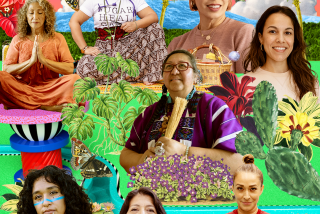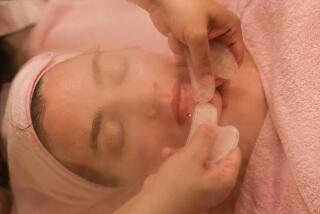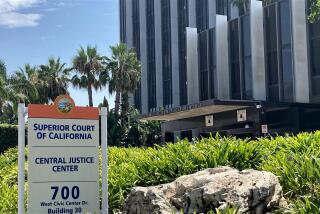A gentle touch with kids
Massage therapist Shay Beider’s clients are usually attached to gawky high-tech machines, intravenous tubes or seated in wheelchairs.
Today, her 4 p.m. appointment is with David Johnson. The 5-year-old, who grabs at the netting around his bed and grunts softly, is relearning how to talk and walk after a hit-and-run accident in April left him in a coma.
Beider rubs scented almond oil into her hands and closes her eyes. As David reaches for a yellow plastic toy box, Beider adjusts her arm underneath his small back and leans in at an angle so she doesn’t disturb his movements.
“It doesn’t look like a spa massage,” Beider says. “The essence is compassion.”
Indeed, massage has a different face when it comes to some of L.A.’s sickest children.
Most kids will spend about a month in Childrens Hospital Los Angeles’ rehabilitation “dome,” a medley of rooms huddled around a small, indoor courtyard with giant skylights. They come here to recover from a variety of afflictions -- accidents, severe burns, multiple strokes. David was hit by a car while crossing the street in his hometown of Palmdale.
Many of the children are experiencing severe pain for the first time in their lives and are on heavy doses of medication. For nearly a year, however, they’ve had another option for pain relief: massage therapy.
Childrens Hospital Los Angeles is the first medical center in the state to offer free massage therapy to young patients. (The hospital refers to it as “compassionate touch.”) Beider and the other therapists work for the Heart Touch Project, a nonprofit group in Santa Monica that was founded to provide free therapeutic massage for HIV patients.
Although several California hospitals use some form of massage, most refer patients to outside therapists. The patients usually pay themselves, because massage is generally not covered by health insurers. Nationally, 90% of hospitals in a recent survey reported that patients pay out of pocket for massage.
During the last decade, massage therapy has gained growing acceptance at U.S. hospitals as research has shown that therapeutic touch can not only ease pain, but also induce weight gain, alleviate depression and boost the immune system.
“It’s only recently that scientific studies have been conducted to document and indeed show that touch has important implications for improving health and well-being, “ says Maria Hernandez-Reif, co-director of the Touch Research Institutes at the University of Miami School of Medicine.
Dozens of studies by the Touch Research Institutes have found that massage can enhance growth of premature infants, diminish pain for fibromyalgia patients and decrease glucose levels in diabetics, among other findings.
The National Center for Complementary and Alternative Medicine, a branch of the National Institutes of Health, is sponsoring several studies on the effects of massage on adults and children.
Dr. Michael Joseph, associate director of the Comfort and Pain Management Program at Childrens, says the hospital’s plan is to bring massage therapy to any patient who might benefit. “We have much bigger goals,” Joseph says.
Four years ago, Beider was planning to attend medical school and was shadowing a Childrens Hospital surgeon. She remembers how terrified a little girl looked in the operating room before surgery. “There are so many procedures that are painful,” says Beider, who thought that a pre-surgery massage might have calmed the girl. “To have a basic, human, deep, gentle touch can have a real impact.”
Children who endure long hospital stays become anxious about having their bodies touched because they associate it with the pain of needles and surgery, Beider says. She started lobbying for a children’s massage program after her experience with the young girl.
“Our goal was really to integrate a more Eastern-thinking intervention into a more Western-thinking institution,” says Jeffrey Gold, a clinical psychologist at Childrens.
There was some initial resistance to the idea, Joseph acknowledges. “There were things that were said like, ‘There’s never going to be a massage therapist that touches my patient,’ ” he says. “Basically we had to write a policy that made the institution comfortable.” And the challenges didn’t stop there. “It took months and months just to figure out what oil we were going to use for the infant massage,” Joseph says.
The hospital has been cautious in other ways. The volunteer therapists must undergo an FBI background check and gain approval from several hospital committees before working with children. After therapists receive hospital privileges, doctors can request that they work with their patients.
The massage therapists get additional training at Heart Touch to prepare them for working with the children and their families. “The hardest thing to teach is to be present and flexible,” Beider says. “They don’t teach you that in massage therapy school.”
On a recent Thursday, massage therapist Amanda Hussein walks in to see Jesse Sanchez. The 10-year-old has chubby hands and smooth cheeks. His mother, Josefina, who speaks little English, explains that he has had multiple strokes.
“When he saw Amanda coming he said, ‘Ay, now I can sleep for a good four hours,’ ” she says.
Hussein asks him what’s been bothering him and then goes to work, kneading her fingers carefully between his knuckles, underneath his back. By the time she reaches his feet, he is snoring quietly.
“He never sleeps like this,” his mother says.
Childrens Hospital sees some of L.A.’s most complex cases, and 80% of its patients are on government health insurance programs. Often, the child’s hospitalization is the family’s biggest crisis, and that creates a challenging situation for the therapist.
“Every time, it’s like starting over,” Hussein says.
Today isn’t Beider’s first session with David. So she starts out like she usually does: greeting David warmly and talking with his mother, Barbara Johnson, a single mom with six other children who drives from Palmdale to see her son once a week. Although parents can stay for the massages, Johnson opts to go for a walk today. Her departure prompts David’s nervous cries.
Beider focuses her eyes on David’s tiny lower back and gently pushes her hands under his shirt. She whispers quietly and walks around him, turning her attention to the crumpled left hand he keeps close to his body. He lies back and cheerily chats with her, forgetting for a moment that his sounds are incompatible with her words.






